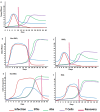Immune Stimulation with Imiquimod to Best Face SARS-CoV-2 Infection and Prevent Long COVID
- PMID: 39062904
- PMCID: PMC11277483
- DOI: 10.3390/ijms25147661
Immune Stimulation with Imiquimod to Best Face SARS-CoV-2 Infection and Prevent Long COVID
Abstract
Through widespread immunization against SARS-CoV-2 prior to or post-infection, a substantial segment of the global population has acquired both humoral and cellular immunity, and there has been a notable reduction in the incidence of severe and fatal cases linked to this virus and accelerated recovery times for those infected. Nonetheless, a significant demographic, comprising around 20% to 30% of the adult population, remains unimmunized due to diverse factors. Furthermore, alongside those recovered from the infection, there is a subset of the population experiencing persistent symptoms referred to as Long COVID. This condition is more prevalent among individuals with underlying health conditions and immune system impairments. Some Long COVID pathologies stem from direct damage inflicted by the viral infection, whereas others arise from inadequate immune system control over the infection or suboptimal immunoregulation. There are differences in the serum cytokines and miRNA profiles between infected individuals who develop severe COVID-19 or Long COVID and those who control adequately the infection. This review delves into the advantages and constraints associated with employing imiquimod in human subjects to enhance the immune response during SARS-CoV-2 immunization. Restoration of the immune system can modify it towards a profile of non-susceptibility to SARS-CoV-2. An adequate immune system has the potential to curb viral propagation, mitigate symptoms, and ameliorate the severe consequences of the infection.
Keywords: COVID-19; Long COVID; SARS-CoV-2 immunization; imiquimod immunostimulation.
Conflict of interest statement
The authors have no financial involvement in any organization or entity with a financial interest in or financial conflict with the subject matter discussed in the manuscript.
Figures



Similar articles
-
mRNA vaccine-induced T cells respond identically to SARS-CoV-2 variants of concern but differ in longevity and homing properties depending on prior infection status.Elife. 2021 Oct 12;10:e72619. doi: 10.7554/eLife.72619. Elife. 2021. PMID: 34636722 Free PMC article.
-
Characterization of SARS-CoV-2-Specific Humoral and Cellular Immune Responses Induced by Inactivated COVID-19 Vaccines in a Real-World Setting.Front Immunol. 2021 Dec 22;12:802858. doi: 10.3389/fimmu.2021.802858. eCollection 2021. Front Immunol. 2021. PMID: 35003131 Free PMC article.
-
Induction of High Levels of Specific Humoral and Cellular Responses to SARS-CoV-2 After the Administration of Covid-19 mRNA Vaccines Requires Several Days.Front Immunol. 2021 Oct 4;12:726960. doi: 10.3389/fimmu.2021.726960. eCollection 2021. Front Immunol. 2021. PMID: 34671348 Free PMC article.
-
Insights into COVID-19 Vaccine Development Based on Immunogenic Structural Proteins of SARS-CoV-2, Host Immune Responses, and Herd Immunity.Cells. 2021 Oct 29;10(11):2949. doi: 10.3390/cells10112949. Cells. 2021. PMID: 34831172 Free PMC article. Review.
-
Impact of Prior COVID-19 Immunization and/or Prior Infection on Immune Responses and Clinical Outcomes.Viruses. 2024 Apr 26;16(5):685. doi: 10.3390/v16050685. Viruses. 2024. PMID: 38793566 Free PMC article. Review.
References
-
- World Health Organization . WHO COVID-19 Dashboard. WHO; Geneva, Switzerland: 2020. [(accessed on 2 July 2024)]. Available online: https://covid19.who.int/
-
- WHO. [(accessed on 20 March 2024)]. Available online: https://covid19.who.int/?mapFilter=vaccinations.
Publication types
MeSH terms
Substances
Grants and funding
LinkOut - more resources
Full Text Sources
Medical
Miscellaneous

